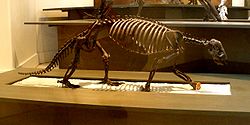Hapalops
| Hapalops | |
|---|---|

| |
| Hapalops ruetimeyeri | |
| Scientific classification | |
| Domain: | Eukaryota |
| Kingdom: | Animalia |
| Phylum: | Chordata |
| Class: | Mammalia |
| Order: | Pilosa |
| Superfamily: | Megatherioidea |
| Genus: | †Hapalops Ameghino, 1887 |
| Type species | |
| †Hapalops rectangularis Ameghino, 1887
| |
| Other species | |
| |


Hapalops is an extinct genus of ground sloth from the Early to Late Miocene of Brazil (Solimões Formation), Bolivia (Honda Group), Colombia (Honda Group),[1] and Argentina (Santa Cruz Formation) in South America.[2]
History
Hapalops was first described by notable Argentine paleontologist and zoologist Florentino Ameghino in 1887, with his description of H. rectangularis as the type species. It was erected based on the posterior part of a left dentary that had been collected from the Miocene aged deposits of Santa Cruz, Argentina, though Ameghino also described a second partial mandible from the same deposits as part of the species, making it a paratype. All of these of these fossils have been lost and their fragmentary status puts the validity of the genus as a whole in jeopardy.[3]
Description
Sloths in this genus had a long, robust body with more than 19 thoracic vertebrae, a short skull, and long limbs with large, curved claws. They were small sloths, measuring about 1 metre (3.3 ft) in length. On the ground, they probably walked on the knuckles of the forelimbs, like a gorilla. Hapalops had very few teeth with no incisors; the mandible included only four pairs of teeth.[4]
Paleobiology
In the Santa Cruz, Hapalops fed on vegetation in intertropical wooded savannahs. It shared its environment with both herbivorous and predatory marsupials, sheep-sized glyptodonts, armadillos, anteaters, toxodonts, typotheres, and litopterns, as well as modern reptiles such as iguanas and birds such as rheas, geese, and hawks. Giant phorusrachid "terror birds" lived in the region and may have been the top predators.[5] Like most extinct sloths it is categorized as a ground sloth, but it is believed that the smaller size of Hapalops allowed it to engage in some climbing behaviors.[6]
Classification
The genus is classified within the Megatherioidea, which includes the megalonychid and the nothrotheriid sloths. While it is generally represented as an outgroup to Nothrotheriidae and a genus of uncertain relationships, it shows most of the character states that diagnose Nothrotheriidae and may be a close relative. At least 26 species in this genus have been named from the same Santa Cruz formation, a biological impossibility largely based on assigning new species names to fossil fragments. The genus awaits revision.[7]
References
- ^ Croft, 2007, p.300
- ^ Hapalops at Fossilworks.org
- ^ Bargo, M. S., De Iuliis, R., & Toledo, N. (2019). "Early Miocene sloths (Xenarthra, Folivora) from the Río Santa Cruz valley (Southern Patagonia, Argentina)". Ameghino, 1887 revisited. Early–Middle Miocene Paleontology in the Río Santa Cruz, Southern Patagonia, Argentina, 130, 102–137.
- ^ Palmer, D., ed. (1999). The Marshall Illustrated Encyclopedia of Dinosaurs and Prehistoric Animals. London: Marshall Editions. p. 207. ISBN 978-1-84028-152-1.
- ^ Farina, Richard A, Sergio F. Vizcaino, and Gerry de Iuliis (2013). Megafauna; Giant Beasts of Pleistocene South America. Bloomington: Indiana University Press. ISBN 9780253002303.
{{cite book}}: CS1 maint: multiple names: authors list (link) - ^ White, J. 1993. "Indicators of locomotor habits in Xenarthrans: Evidence for locomotor heterogeneity among fossil sloths". Journal of Vertebrate Paleontology, 13(2): 230–242
- ^ Pujos, François; De Iuliis, Gerardo; Quispe, Bernardino Mamani (September 2011). "Hiskatherium saintandrei, gen. et sp. nov.: an unusual sloth from the Santacrucian of Quebrada Honda (Bolivia) and an overview of middle Miocene, small megatherioids". Journal of Vertebrate Paleontology. 31 (5): 1131–1149. Bibcode:2011JVPal..31.1131P. doi:10.1080/02724634.2011.599463. ISSN 0272-4634. S2CID 86755668.
Bibliography
- Croft, Darin A (2007). "The Middle Miocene (Laventan) Quebrada Honda Fauna, southern Bolivia and a description of its Notoungulates". Palaeontology. 50 (1): 277–303. Bibcode:2007Palgy..50..277C. doi:10.1111/j.1475-4983.2006.00610.x. S2CID 140161482.
- Prehistoric sloths
- Prehistoric placental genera
- Miocene xenarthrans
- Miocene mammals of South America
- Huayquerian
- Chasicoan
- Mayoan
- Laventan
- Colloncuran
- Friasian
- Santacrucian
- Neogene Argentina
- Fossils of Argentina
- Neogene Bolivia
- Fossils of Bolivia
- Neogene Brazil
- Fossils of Brazil
- Neogene Colombia
- Fossils of Colombia
- Honda Group, Colombia
- Fossil taxa described in 1887
- Taxa named by Florentino Ameghino


